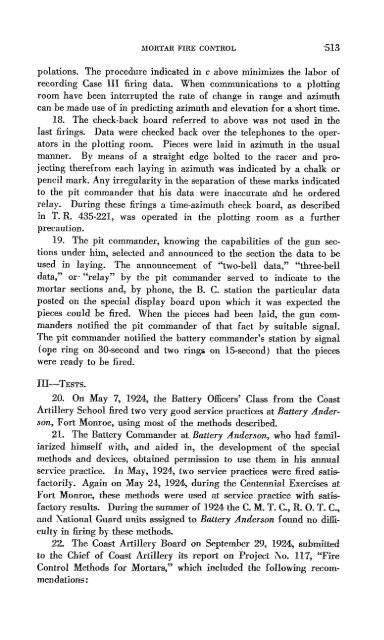COAST ARTILLERY, JOURNAL - Air Defense Artillery
COAST ARTILLERY, JOURNAL - Air Defense Artillery
COAST ARTILLERY, JOURNAL - Air Defense Artillery
You also want an ePaper? Increase the reach of your titles
YUMPU automatically turns print PDFs into web optimized ePapers that Google loves.
MORTAR FIRE CONTROL -513<br />
polations. The procedure indicated in c above minimizes the labor of<br />
recording Case III firing data. When communications to a plotting<br />
room have been interrupted the rate of change in range and azimuth<br />
can be made use of in predicting azimuth and elevation for a'short time.<br />
18. The check-back board referred to above was not used in the<br />
last firings. Data were checked back over the telephones to the operators<br />
in the plotting room. Pieces were laid in azimuth in the usual<br />
manner. By means of a straight edge bolted to the racer and pro.<br />
jecting therefrom each laying in azimuth was indicated by a chalk or<br />
pencil mark. Any irregularity in the separation of these marks indicated<br />
to the pit commander that his data were inaccurate and he ordered<br />
relay. During these firings a time-azimuth check board, as described<br />
in T. R. 435-221, was operated in the plotting room as a further<br />
precaution.<br />
19. The pit commander, knowing the capabilities of the gun sections<br />
under him, selected and announced to the section the data to be<br />
used in laying. The announcement of "two-bell data," "three-bell<br />
data," or- "relay" by the pit commander served to indicate to the<br />
mortar sections and, by phone, the B. C. station the particular data<br />
posted on the special display board upon which it was expected the<br />
pieces could be fired. When the pieces had been laid, the gun commanders<br />
notified the pit commander of that fact by suitable signal.<br />
The pit commander notified the battery commander's station by signal<br />
(0V-e ring on 3D-secondand two ring£ on IS-second) that the pieces<br />
were ready to be fired.<br />
III-TESTS.<br />
20. On May 7, 1924, the Battery Officers' Class from the Coast<br />
<strong>Artillery</strong> School fired two very good service practices at Battery Anderson,<br />
Fort Monroe, using most of the methods described.<br />
21. The Battery Commander at Battery Anderson, who had familiarized<br />
himself with, and aided in, the development of the special<br />
methods and devices, obtained permission to use them in his annual<br />
service practice. In May, 1924, two service practices were fired satisfactorily.<br />
Again on :May24, 1924, during the Centennial Exercises at<br />
Fort Monroe, these methods were used at service practice with satisfactory<br />
results. During the summer of 1924 the C. M. T. C., R. O. T. c.,<br />
and ~ational Guard units assigned to Battery Anderson found no difficulty<br />
in firing by these methods.<br />
22. The Com:t<strong>Artillery</strong> Board on September 29, 1924, submitted<br />
to the Chief of Coast <strong>Artillery</strong> its report on Project ;'\0. II7, "Fire<br />
Control Methods for Mortars," which included the following recommendations:
















